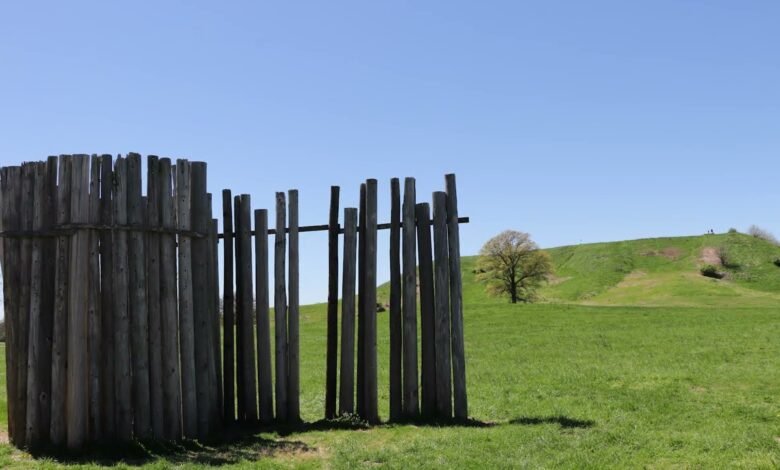A Beginner’s Journey: How to Draw a Mississippian Guard Tower from History to Sketchbook

Have you ever looked at a towering structure and felt the pull of its untold stories? The Mississippian Guard Tower, a historical marvel from a bygone civilization, is one such structure that still fascinates artists, historians, and architects alike. These ancient towers weren’t just defensive structures; they stood as symbols of protection, community, and resilience in the heart of Mississippian settlements.
In this guide, we’ll take you on a creative journey where the past meets the present—teaching you how to draw a Mississippian Guard Tower while learning about its cultural importance. Whether you’re new to drawing or looking to expand your artistic horizons, this step-by-step article will help you connect with ancient history through your own creative expression.
Understanding the Mississippian Guard Tower
Before you put pencil to paper, it’s helpful to understand what a Mississippian Guard Tower actually is. Built by the Mississippian culture—an advanced Native American civilization that flourished from 800 to 1600 CE in the southeastern United States—these towers were primarily used for lookout and defense.
Constructed using earth, timber, and other locally available materials, the Mississippian Guard Tower served a dual purpose: as a surveillance post and as a symbol of unity and strength for the community. The design and structure varied slightly across regions, but all shared a core principle of elevated protection and visibility.
What You’ll Need: Essential Materials and Tools
Getting the right materials is the first step to effectively sketching a Mississippian Guard Tower. Here’s a checklist to prepare:
- Sketchbook: Opt for one with thick pages that can handle ink, watercolor, or layering techniques.
- Pencils: Use a range from H (hard) for fine lines to B (soft) for shading and texture.
- Eraser: A kneaded or standard eraser helps correct mistakes without damaging the paper.
- Fine liners or ink pens: These are great for finalizing outlines after your base sketch.
- Ruler or straight edge: Architectural drawings benefit from precision, so keep one handy.
- Color tools (optional): Colored pencils, watercolors, or markers can bring your Mississippian Guard Tower to life with vibrant historical tones.
Step-by-Step Guide: Drawing a Mississippian Guard Tower
1. Sketching the Foundation
Begin with a wide, stable rectangle to serve as the base of your Mississippian Guard Tower. This foundation is vital—it represents strength and longevity, echoing the historical purpose of the structure.
2. Creating the First Level
Draw vertical lines from each corner of the base and connect them at the top with a horizontal line. This forms the first level of the tower and sets up the general height and perspective. Keep your lines clean and symmetrical.
3. Adding Core Architectural Details
This is where your Mississippian Guard Tower comes alive. Sketch in doorways and windows, keeping in mind that many towers featured both functional and decorative elements. You can include triangular roofs or small platforms, drawing inspiration from authentic archaeological findings.
4. Building Upper Levels
If you want to elevate the structure further, add another level on top by repeating the previous steps. Ensure each level aligns with the one beneath it to maintain structural consistency in your sketch.
Enhancing with Designs: Capturing Cultural Aesthetics
Now that the structure is in place, it’s time to inject personality and historical relevance into your drawing.
Incorporate Decorative Windows
Windows in a Mississippian Guard Tower were more than just lookout points; they also reflected the tower’s artistic side. Try various window shapes—round, arched, or rectangular—to enrich your design.
Embellish the Tower Walls
Use geometric motifs inspired by Mississippian art, such as zigzags, spirals, or natural patterns like feathers and leaves. These decorative elements speak to the creativity and craftsmanship of ancient tower builders.
Experiment with Texture and Shading
Add depth by using shading techniques like hatching or crosshatching. Texturing the walls to resemble wood grain or stonework can give your Mississippian Guard Tower a weathered, realistic feel.
Final Touches: Completing Your Guard Tower Drawing
You’re nearly done! Now it’s time to refine and enhance your masterpiece.
- Clean up lines: Go over your drawing and reinforce the outlines with a fine liner or pen.
- Highlight architectural features: Emphasize balconies, structural beams, and support braces for added depth.
- Apply shading thoughtfully: Determine where the light source hits and use shading to create a three-dimensional effect.
- Review from afar: Take a step back from your drawing to spot any asymmetry or areas that need enhancement.
The finishing phase is where your Mississippian Guard Tower truly comes to life—standing tall and detailed, ready to tell its ancient story.
Artist’s Tips: Boost Your Drawing Skills
Whether this is your first time drawing a Mississippian Guard Tower or your hundredth artistic challenge, these tips will help:
- Practice consistently: Sketch a little each day to improve control and build confidence.
- Break down shapes: Simplify complex features into basic forms like rectangles and circles.
- Try different styles: Use pencil, ink, charcoal, or even digital tablets to find your preferred medium.
- Join a community: Online forums and social media art groups can provide helpful feedback.
- Keep a sketch journal: Document ideas, historical notes, or new techniques that inspire you.
Fascinating Facts About the Mississippian Guard Tower
Here are some quick, engaging facts about the Mississippian Guard Tower that may surprise you:
- Material Choices: Most towers were constructed with wooden beams and packed earth—effective and sustainable!
- Strategic Height: Their elevated design allowed guards to survey vast distances, protecting the community.
- Design Variety: Some towers were minimal, while others featured artistic patterns and additional stories.
- Cultural Symbols: Beyond defense, these towers represented community cooperation and territorial boundaries.
- Archaeological Evidence: Excavations across the southeastern U.S. have revealed postholes and remains of these towers near mound sites.
These historical tidbits can inspire new artistic angles and interpretations for your next Mississippian Guard Tower drawing.
Conclusion: Bringing Ancient Architecture to Life
Drawing a Mississippian Guard Tower is more than just a creative exercise—it’s a way to connect with the ingenuity and culture of an ancient civilization. With each line and shade, you’re retelling stories of resilience, strength, and artistic brilliance.
As you continue to develop your artistic abilities, let these towers serve as a bridge between eras—reminding us of how powerful and meaningful art rooted in history can be.
So grab your sketchbook, tap into your imagination, and let your pencil carve out the spirit of the Mississippian Guard Tower.
FAQs:
Q1: What is a Mississippian Guard Tower?
A Mississippian Guard Tower is a defensive structure built by the Mississippian culture, typically for protection and surveillance. These towers were key elements in community planning and symbolized strength and unity.
Q2: What materials should I use to draw a Mississippian Guard Tower?
You’ll need a sketchbook, pencils (H to B range), erasers, fine liners for inking, a ruler, and optional color tools like colored pencils or watercolors.
Q3: How do I start drawing a Mississippian Guard Tower?
Start with a rectangular base, then build vertical lines for the first level. Add windows, roofing, and additional levels or decorative patterns inspired by history.
Q4: What artistic details should I include?
Incorporate functional elements like doors and windows, then add texture with shading and embellishments like geometric or natural motifs reflective of Mississippian culture.
Q5: How can I improve my drawing over time?
Practice daily, study basic shapes, try various mediums, seek constructive feedback, and keep a sketch journal for ongoing inspiration.
Keep an eye for more news & updates on Evolant Agency!




